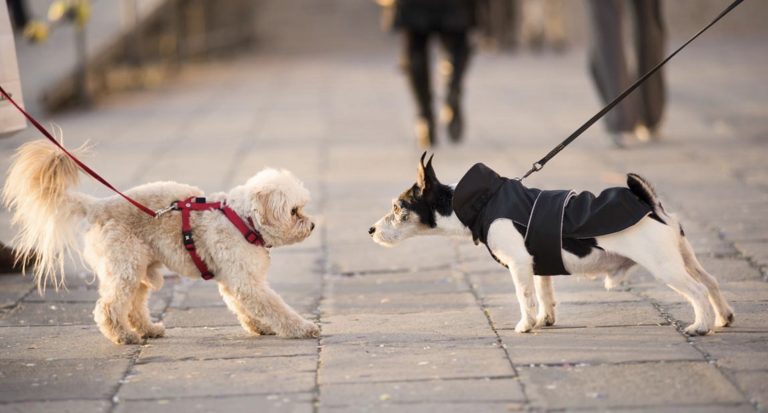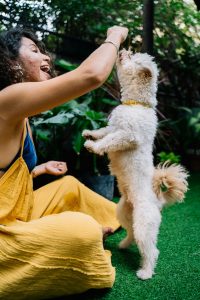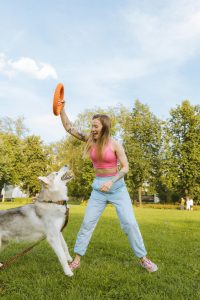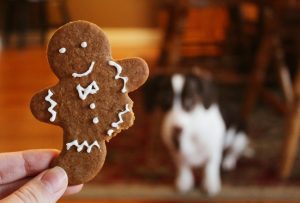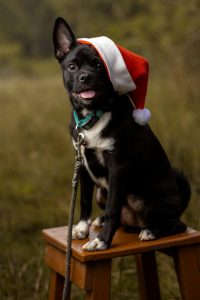Why do dogs fight? Well, because they are dogs. They cannot get along with every other dog in the world. Can you name one person who gets along with everybody else? I can wait… It is impossible to ask dogs to get along with every other dog they meet.
What you can do is restrict his interactions with other dogs. That doesn’t mean you should put your dog in a cage. But you can generally see whether your or the opposing dog will react. And this is where this technique helps. We will talk more about the puppy reactivity chart later on. But let’s see how this technique works first.
What is the stimulus blocking technique?
Let’s start by explaining one part of the term first. A stimulus, or trigger, is a thing or event that evokes a specific functional reaction. It is a thing that arouses activity or energy in someone or something.
With that logic, stimulus blocking is a way to block the trigger. In this case, the trigger is a dog walking your way and your dog reacting to it. Remember, not all dogs love other dogs.
How do you play this game? Well, first you need to teach your dog to take a toy.
In quick steps, you present an object to your dog, you give him a command to pick it up, praise, reward, and then reward when he touches the object. Repeat a few times, and once your dog understands to pick up the object, you teach him to pick it up and then add the hold command.
For this technique, we can use a tug toy. We want our dog to take the tug toy, and engage with us. Why? Because when he engages with us and plays with the tug toy, he is not looking at the other dog. Instead, your pup is looking at you.
And most importantly, your puppy is not freaked out by the other dog. He simply doesn’t see it. And the other puppy is relaxed because he is not under any pressure.
With one simple technique, you can calm down the situation.
Dog reactivity chart
When you approach other dogs, you can generally see if that dog will cause anxiousness and nervousness in your dog. How? Well, look at the other dog’s body language and how he moves towards you. And see how your dog is reacting.
Generally speaking, here is a reactivity chart that can help you recognize the problem:
- Red zone includes barking, lunging, not responding to cues and treats
- Orange zone includes high body tension, straining on leash, might growl, single woofs, doesn’t eat anymore
- Yellow zone includes alertness, stares at the trigger, no longer sniffs around, and might need several cues to change direction
- Green zone is when your or the opposite dog sniffs, follows cues, keeps leash completely relaxed, and takes treats
So, logic dictates that you let your dog sniff another dog if the opposite dog and your dog are in the green or maximum yellow zone. If either of the dogs is in the red or orange zone, you should use the stimulus blocking technique to shift his focus to something else.
Practice and repeat the technique
You can easily practice this technique at home with your friends. You want to prepare yourself for the situation in real life. And what you can do is proof it at home.
Ask a friend to come over with his dog. And then, as soon as your dog sees that other dog, you give him the tug toy we talked about earlier.
Then, have the triggering dog leave the situation. This teaches your dog that he gets awesome toys when a scary dog approaches. And when the situation calms down, he can go back to sniffing and walking.
You want to start at a large distance and then work your way up to being close to the other dog. Do not go head to head instantly. Give your dog time and practice to understand the situation and what he needs to do. You do not want your dog to feel overly stressed or anxious during training.
If you see that your dog does not accept the tug toy or stays focused on the other dog, increase the distance. Go back a few feet.
Repeating the same situation over and over, your dog will increase his tolerance and you can soon approach dogs on walks. Depending on the reactivity chart, you can decide whether to have your dog sniff the other pup or you should bring out the tug toy.

